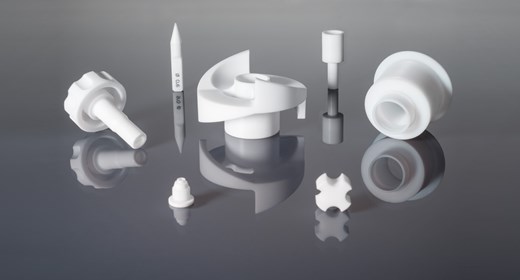PEEK has excellent mechanical properties and high levels of corrosion resistance, making it an ideal choice for global manufacturers. This article introduces the basic knowledge of machining PEEK: the material properties of PEEK, the advantages of machining PEEK, the common applications of machining PEEK and the skills of how to make full use of machined PEEK parts.
What Is PEEK?
PEEK or polyetheretherketone is a high-performance engineering thermoplastic, usually classified as industrial grade or medical grade, and is part of the PAEK series of materials. Semi-crystalline materials are used in various industrial parts and components, have excellent strength, wear resistance and dimensional stability, and can maintain their performance even at high temperatures.
PEEK has chemical resistance and water resistance similar to PPS. But PEEK has a melting point of 343°C, so it can operate at higher temperatures: it can be used continuously up to 250°C and can be used in hot water or steam without permanent loss of physical properties.

PEEK For CNC Machining
PEEK is a semi-crystalline thermoplastic that can operate continuously at temperatures up to 250°C, while also having high chemical resistance. However, it must be noted that certain acids (such as sulfuric acid) will dissolve the material. Another application of PEEK is when good chemical resistance is required, when PEEK plastic is used instead of fluoropolymer at high temperature, PEEK plastic is usually used. These characteristics are very suitable for use in the medical industry, aerospace industry, semiconductor and oil and gas industries.
Advantages Of PEEK
PEEK has many advantages, which can be divided into two categories: the inherent material advantages of PEEK, and the specific process advantages of using CNC machine to process PEEK materials.
The Material Advantages Of PEEK:
- Excellent chemical resistance
- Excellent mechanical properties
- Very low moisture absorption rate
- Abrasion resistance
- Not affected by continuous hot water/steam contact
- Resistant to biodegradation
- Can keep high temperature
- Dimensional stability
- Non-flammable
- High impact strength
The Technological Advantages Of Machining PEEK:
- High precision
- High repeatability
- Tight tolerances
- Relatively high melting point allows faster feed and speed
Limitations Of PEEK Machining
Although many mechanics use PEEK plastic as a reliable substitute for certain metals, there are still some limitations in machining thermoplastic polymers. These include:
- Special treatment is required to minimize internal stress and heat-related cracks
- Need annealing
- Poor heat dissipation
- If you drill deep, it may break
Application Of PEEK machining
PEEK is a material with a surprisingly diverse range of applications, some of which are better processed by CNC than other manufacturing techniques. Industrial grade PEEK plastic is used in the aerospace, automotive, chemical, electronics and energy industries, while medical grade PEEK plastic is used in healthcare and dentistry.
Industrial-grade
Rollers and wheels
Bearings
Washers, seals & manifolds
Blocks
Medical-grade
Implants
Spinal fusion devices
Trauma fraction devices
Orthopedic devices
The above are some examples of industries and components suitable for PEEK. This is by no means an exhaustive list. If you are considering using PEEK, please get in touch with us and we can discuss the entire project with you.

PEEK Machining Tips
PEEK is a machineable thermoplastic, but critical steps must be taken before, during and after processing to provide the best final product.
Annealing:
Annealing is a process performed on PEEK rods to relieve stress and reduce the chance of stress and surface cracks in the PEEK material during machining. Annealed PEEK is also unlikely to deform. Depending on the time required for processing, multiple annealing stages may be required.
Cutting Tools:
In most cases, you can use silicon carbide cutting tools to process PEEK. If PEEK is reinforced with carbon fiber or requires particularly tight tolerances, diamond tools should be used. In addition, if the cutting tool used is also not used on metal, contamination can be avoided.
Wet Or Dry:
Since PEEK does not emit heat, it needs to be cooled during processing to prevent deformation or cracking. Standard liquid coolants can be used, unless the medical component is being processed, in which case the PEEK material needs to be cooled by compressed air. This is because the liquid coolant will affect the biocompatibility of PEEK.
Drilling:
Since PEEK has a lower elongation than other plastics, deep hole drilling may cause cracks.
SANS Machining uses the latest technologies and highest quality standards, supported by superior customer service to provide each customer with a finished part that meets or exceeds expectations, is delivered on time and on budget.


